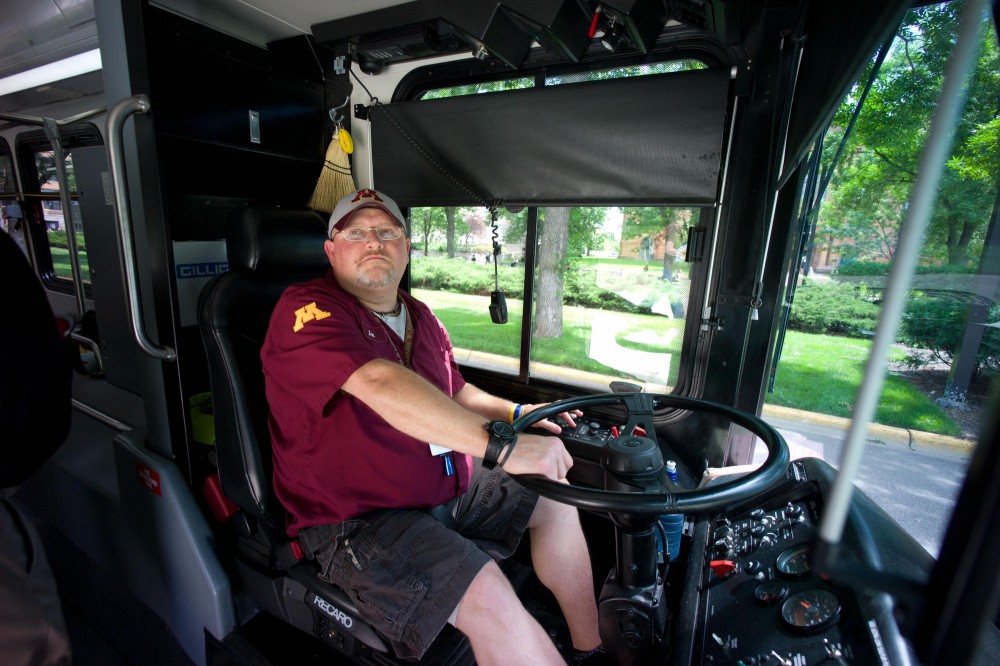On a hot summer day last week, Joe Filey navigated through the University of Minnesota campus behind the wheel of a 40-foot Campus Connector bus, skillfully maneuvering tight corners and narrow roads as pedestrians crowded adjacent sidewalks.
The route requires drivers to be ever-attentive of their surroundings, to check their mirrors and anticipate moves long before they make them.
âÄúItâÄôs no Sunday drive,âÄù Filey said as he crossed the 10th Avenue Bridge on Thursday.
It took Filey hours of in-class and behind-the-wheel training to hone the necessary skills of a driver for First Transit, the bus company the University contracts to operate Campus Connectors and Circulators.
Prospective drivers spend about 80 hours of training before driving by themselves âÄî four days in the classroom learning about company policy and driving tactics and an average of 40 hours of behind-the-wheel training.
After that, a driver spends another 14 hours learning a route, First Transit general manager Paul Buharin said.
John Garceau, a safety manager for First Transit, said the company likes to âÄúseasonâÄù the drivers for at least a year before they take on a campus route.
Filey spent four months on another of the companyâÄôs metro routes before hopping on the connector. This fall will be his fourth year on campus.
âÄúItâÄôs a very different environment,âÄù Garceau said. âÄúSo rather than throw them to the hounds, if you will, we like to prepare them a little bit and hone their skills before we put them on campus.âÄù
The training program today is much more extensive and structured than when Garceau came to the company in 1992, he said. Since then, the company has been sold several times and went through different name changes. Each incarnation had a different setup for bus training.
Safety First
Safety posters line the walls of a small classroom in First TransitâÄôs office near Hennepin Avenue north of campus, reminding drivers to put away cell phones and give other vehicles enough room in front of the bus.
On the whiteboard in front of the classroom, instructor Kelly Daily reminded drivers that the large vehicles theyâÄôll drive wonâÄôt handle like a car: âÄúYou are driving a bus, not a Ferrari,âÄù he wrote.
The six drivers in attendance Tuesday morning watched as âÄô70s disaster movie star George Kennedy recited the tenets of the Smith System âÄî a driving instruction technique designed to encourage safe driving habits like checking mirrors and making sure other drivers can see the bus.
Every video during the two-hour session on defensive driving included a segment on the Smith System, each repeating the lessons of the previous tape with additional advice on how to merge lanes and avoid road rage.
The biggest challenge in training is getting the drivers to keep up the habits they learned once theyâÄôre out on the roads, Buharin said.
The initial training is only the beginning of the ongoing learning process of being a Campus Connector driver. They often hold safety meetings and annual training sessions, he said.
âÄúThatâÄôs really our focus: to develop these skills weâÄôve conveyed into solid habits that they can take with them,âÄù Buharin said.
No experience necessary
While Buharin was a student at the University in the mid-âÄô80s, he drove the predecessor of Campus Connectors. It was a good job for a student, he said, because he had some downtime to study and finish homework.
Buharin had prior experience and a commercial license to drive buses. For his summer job during high school, he transported French foreign exchange students from his hometown of Rochester, Minn. to OâÄôHare International Airport in Chicago.
Some schools still employ students to drive buses, Parking and Transportation Services spokeswoman Jacqueline Brudlos said in an email, âÄúbut we feel that professional drivers are more experienced and safer.âÄù
But itâÄôs not common for a First Transit driver today to have prior experience driving a bus, Buharin said. And thatâÄôs the way they prefer it.
âÄúThen they donâÄôt have preconceived notions,âÄù he said. âÄúWe like them to come with an open mind.âÄù
Drivers that have no experience driving a large vehicle have to do some training in a parking lot to learn how to maneuver the bus around cones. They donâÄôt need a special driverâÄôs license when hired, but must have five years of driving experience.
Filey had experience driving delivery trucks before he came to First Transit. But the connectors are much slower and turns are more difficult, he said.
Every July, First Transit holds a drawing for drivers to determine the routes theyâÄôll drive for the next year. The drawing order is based on seniority.
Although the campus route is not necessarily more popular than others, Filey enjoys the pace of campus and the people that ride his bus. ItâÄôs a job that keeps him on his toes, he said, but the training prepared him for it.
âÄúThey teach you to not take chances, to go slow,âÄù Filey said. âÄúYouâÄôre driving a 40,000-pound bus. ItâÄôs not very forgiving.âÄù


